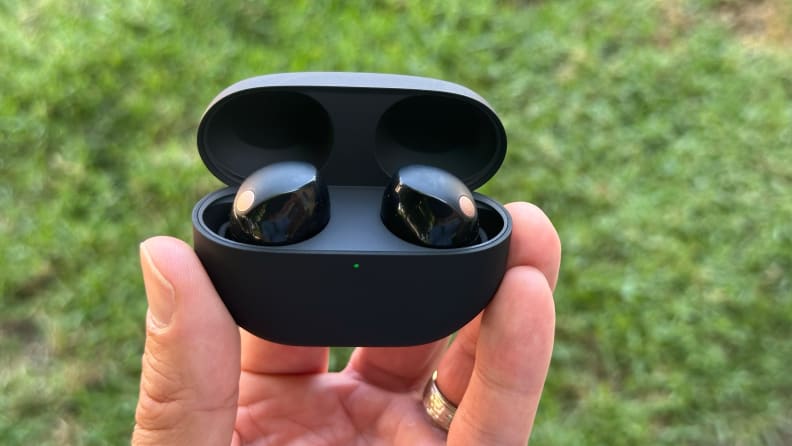
For years, great active noise cancellation (ANC) was reserved for over-ear headphones, but that’s no longer the case. Now true wireless earbuds offer surprisingly good noise canceling, perfect for all kinds of use cases.
We’ve tested dozens of pairs to find the cream of the crop. If you want the best active noise canceling performance available, the Sony WF-1000XM5
(available at Amazon for $298.00)
are at the top of the ANC mountain, while also delivering excellent sound, customizability options in the Sony Headphones app, and great touch controls.
If the WF-1000XM5 aren’t what you’re looking for, there are plenty of other top performers listed below at multiple price points, so you can find the perfect pair of noise-canceling earbuds to grant you the lovely sound of silence.

Credit:
Reviewed / John Higgins

Not only do the Sony WF-1000XM5 deliver the best noise-canceling performance, they sound excellent, too.

Credit:
Reviewed / John Higgins

The Anker Soundcore Space A40 earbuds deliver the best ANC performance you can get for under $100.

Credit:
Reviewed / Ryan Waniata

The Apple AirPods Pro (2nd generation) deliver significant upgrades to noise canceling, transparency mode, and sound.

Credit:
Reviewed/Ryan Waniata
The Jabra Elite 7 Active are fantastic workout earbuds.
Other Top Noise-Canceling Earbuds We Tested
How We Test Noise-Canceling Earbuds
The Testers
John Higgins is Reviewed’s Managing Editor of Tech. He’s been immersed in audio from a young age, starting with piano in the early ’80s before discovering a variety of other instruments and recording techniques. After earning an audio production degree and post-grad in music performance, he began covering audio products with Home Theater Magazine in 2003 while working as a professional musician and sound editor for films.
Other contributors to this list include Reviewed’s former Managing Editor Ryan Waniata, former Home Theater editor Lee Neikirk, and Reviewed contributor Nick Woodard, a tech journalist specializing in smart home products and all things related to home theater.
The Tests

Credit:
Reviewed.com / TJ Donegan
True wireless earbuds all come with two individual buds—no wires between them—and a charging case.
To find the best ANC earbuds, we put a laser-sharp focus on active noise canceling, but we also took note of several issues consumers typically run into when buying both wireless and “true wireless” earbuds (those completely free of any wires). In addition to sound quality, noise isolation, and comfort, we analyze each on battery life, ease of use, controls, and wireless range.
We put the earbuds through a battery of basic audio tests to judge noise canceling across low and high frequencies, as well as passive and active noise attenuation to see how well each earbud blocks outside noise. From there, we use all the earbuds extensively, playing test tracks from a wide variety of musical genres.
We further test the noise canceling in a variety of environments, including using professional speakers blasting airplane engine drone, a pink noise generator, and a crowd noise emulator in an acoustically treated environment. We also test them in real-world scenarios, including (when possible) airplane travel, walking around busy streets, and yard work like mowing the lawn or using a leaf blower.
Other real-life tests include sweat proofing, short- and long-term comfort, measuring a full charge of battery life at medium volume, taking phone calls, and testing connectivity over distances and through obstacles like doors and walls. All of this data is compiled in our master rubric to determine rankings as scientifically as possible.
To account for durability, which wireless earbuds have struggled with, we note any major issues that popped up in user reviews (where available), and retest the earbuds after firmware updates. We also use these earbuds over a prolonged period and update their firmware when available to test out the latest features.
What You Should Know About Buying Noise-Canceling Earbuds
Knowing the basic terminology of noise-canceling earbuds, can help you find your footing as you decide which features you truly need, and where you may want to compromise to fit your budget.
What is active noise canceling?
Originally developed for pilots, noise-canceling technology utilizes tiny microphones to reduce the impact of ambient noise around you using phase cancellation of unwanted frequencies. ANC headphones have become a mainstay for travelers, public transit commuters, gym-goers, and others looking to eliminate background noise. All of our picks here feature at least mid-level ANC, though their effectiveness across frequencies varies.
What is transparency mode?
Transparency mode, also called hear-through mode or ambient sound mode, uses tiny microphones just like noise canceling, but in this case they pipe in sound to keep you aware of your environment. Not all transparency modes are created equal, and how a headphone’s hardware and software handle things like wind gusts can make a serious difference in the feature’s utility.
What are Bluetooth headphones?
Bluetooth headphones let you unplug from your source device, while “true wireless” earbuds offer totally wire-free listening with no cable between the earbuds. Bluetooth range defaults at 33 feet in its current iteration, though effectiveness will vary based on many factors, including antenna strength of both your source device and your headphones, as well as barriers like doors or walls.
Dust and water resistance ratings
IP is a rating used across a wide array of electronics that signifies how well the device takes on the elements. You’ll often see the code “IPX” with a number at the end, or you may see codes like IP67, etc. The first number is dust resistance—how well the product stands up to ingress. The second number is water resistance. The higher those numbers, the better. You can find more info in our water resistance guide.
More Articles You Might Enjoy
 Print
Print






